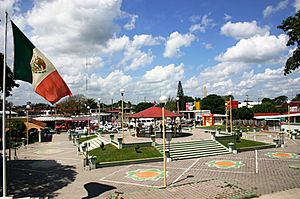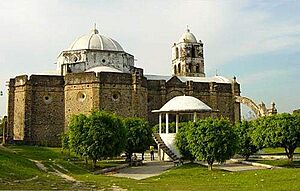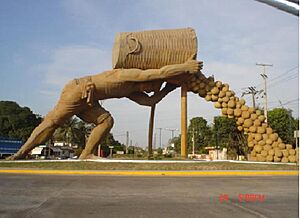Álamo, Veracruz facts for kids
Quick facts for kids
Álamo
|
|
|---|---|
|
Municipality and City
|
|

Plaza Benito Juárez
|
|
| Country | Mexico |
| State | Veracruz |
| Municipality | Temapache |
| founded | 1906 |
| Population
(2010)
|
|
| • Total | 25,159 |
| • Summer (DST) | UTC-5 (-6) |
| Climate | Aw |
| Website | www.temapache.gob.mx |
Álamo is a city in the Mexican state of Veracruz. It's the main town of the Temapache municipality. In 2010, about 24,159 people lived there. The city became an official "city" in 1973. Its name comes from the many álamo trees (which are a type of plane tree) that grow along the Pantepec River. The most important business in Álamo is growing oranges!
Contents
History of Álamo
Before Europeans arrived, the area where Álamo is now was home to the Huastec people and later the Aztecs.
Ancient Cultures
Around 800 to 1300 AD, long before the Aztecs took over, the Totonac and Huastec cultures lived here. You can still find ancient altars, called cues, along the banks of the Pantepec River from that time.
Early Modern Times
In 1683, Dutch pirates like Laurens de Graaf (known locally as "Lorencillo") and Nicholas van Hoorn caused trouble in the region. They were capturing and looting the port city of Veracruz.
The area was given a special title, "Heroico Temapache de Gutiérrez Zamora," in 1878. The city of Álamo itself grew from a small farming village. Many people moved there from the countryside to find work.
Modern History
During the Mexican Revolution, a general named Manuel Peláez controlled this region with his small army.
In 1912, an oil company called Penn-Mex Fuel Oil started drilling the Álamo Well no. 1. This brought many workers to the area. Álamo officially became a town in 1926. It was made a municipality in 1927, thanks to Guillermo Velez, who became its first elected mayor. In December 1973, Álamo was officially recognized as a city.
Archaeology Discoveries
In January 2021, archaeologists found an amazing 500-year-old limestone statue. It was discovered in an orange orchard in a town called Hidalgo Amajac, near Álamo. The statue shows a mysterious woman wearing a large headdress, detailed clothes, and jewelry. She has tassel-like earrings and a round necklace called "oyohualli."
This is the only statue of its kind ever found in the area. Because of how she is posed and dressed, experts think she was a very important person, possibly a ruler, in her time. The statue is about 60 centimeters wide and 25 centimeters thick.
Álamo's Coat of Arms
The city's coat of arms, or shield, tells a story about Álamo. It shows a corn cob held by two hands, with an orange in the background. This represents the farming that happens in the region.
At the top, you can see the President José López Portillo bridge. This bridge is at the city's entrance and stands for progress. On the top left, there's a factory, which shows the juice industry. On the top right, there's a cow's head, representing the livestock farming. The bottom of the shield has two branches of tobacco leaves. Below them is the full name of the municipality: Temapache Álamo, Veracruz.
Geography and Climate
Álamo is located in the northern part of Veracruz. It sits about 40 meters (131 feet) above sea level. The city is about 380 kilometers (236 miles) north of Xalapa, the state capital.
The climate in Álamo is hot and can be extreme. The average temperature each year is 24 °C (75 °F). It also gets a lot of rain, about 1,391 millimeters (54.8 inches) annually.
People of Álamo
About 10,000 people in Álamo speak native languages, mostly Nahuatl. The main religions practiced here are Catholicism and Protestantism.
In 2000, there were 22,011 homes in the city. On average, about 4.6 people lived in each home.
Education in Álamo
Álamo has many schools for young people. There are 149 preschools, 179 elementary schools, and 47 secondary schools. For older students, there are also 15 colleges or higher education institutions.
Farming and Livestock
Farming is very important in Álamo. The main crops grown here include maize (corn), beans, citrus fruits (like oranges), watermelon, papaya, and pipián (a type of squash).
Raising animals is also a big part of the local economy. In the municipality, there are many animals, including over 431,000 cattle, 7,155 pigs, 7,200 sheep, and 5,675 horses.
Tourist Attractions
Álamo has several beautiful churches to visit. These include the Church of Santiago Apostle, which dates back to the 16th century, and the Church of Pasture the Plain of Our Lady of Carmen.
Other fun places to see are the Hacienda de la Noria, the Salto Waterfalls, the area known as "5 Towns," and the Bridge of the Congregation of Limonar. You can also enjoy the beaches along the banks of the Pantepec River.
Delicious Food
The region has some unique and tasty dishes!
- Zacahuil: This is a special type of tamal. It's made from dough, chili, and either pork or chicken. It's wrapped in a banana leaf and cooked in a clay oven.
- Huasteco Dish: This meal includes sausage, corned beef, ham, bacon, and fried plantains. It's served with beans and a green sauce called salsa verde.
- Other local favorites include "Acamaya Soup," "huatape," "enchiladas de baile," and "barbecue beef."
Local Traditions
Álamo is rich in traditions and celebrations!
Carnival
Carnival is a big party that starts 40 days before Lent and ends before Ash Wednesday. Many dance groups perform during this time. Some groups are casual, while others are very well-rehearsed. The local people sometimes call these dancers Malinche. There's a growing interest in bringing back older traditions for Carnival, like using traditional wooden masks and playing band music.
Orange Fair
The annual Orange Fair is a huge event held during the last week of April. In 2010, it was called "CitroFest 2010." The fair covers a large area, with space for international speakers and business meetings. This allows orange growers to connect with big stores and customers.
The fair also features a bullring, a public theater, sculptures made from oranges, and live music. You can also see farming equipment, go shopping, enjoy local food, and ride carnival attractions.
One of the most exciting parts of the fair is the Colotero Race. Competitors carry a basket full of oranges, weighing up to 70 kilograms (154 pounds), on their backs. The basket is held by a strap around their forehead. The race is usually about a mile long. If a runner drops their basket, they are automatically out of the race!
Feast of Our Lady of Sorrows
From September 13th to 15th, Álamo celebrates the Virgin of Our Lady of Sorrows. During these days, people perform traditional dances from the region. There are also religious and cultural events, with lively music played on jaranas and violins, which are traditional instruments of the Huasteca area.
Day of the Lost Child
The Day of the Lost Child (el día del niño perdido) is a religious tradition held on December 7th. It started a long time ago with the first Christian missionaries in the area. People light a candle to remember the story.
This tradition is based on a Bible story from the Gospel of Luke. It tells how Jesus stayed behind in Jerusalem when he was a child, and his parents didn't know. They searched for him for three days and finally found him at the Temple.
Sunday Market (Tianguis)
The traditional Sunday market, called tianguis, takes place in Álamo Plaza. This type of market has been around since before Europeans arrived, when the Aztecs controlled the area. You can find all sorts of things for sale, including handmade goods, and delicious foods. Some popular items are zacahuil alamenses, cassava brown sugar, and homemade bread.
See also
 In Spanish: Álamo (Veracruz) para niños
In Spanish: Álamo (Veracruz) para niños





